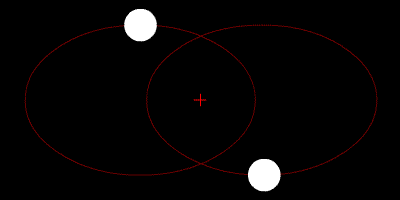Planet Info
Solar System
Throughout this document I’ll refer to each of the stars in the system as the Usaq do: as “Father” and “Son”.
Landfall orbits Father, so is apparently much larger than Son, but also Son is objectively smaller. Details below.
Father star and Son star orbit each other closely and are about evenly matched, Father being ~1.2 sol radii, and Son being ~.9 sol radii.
The main stars orbit similarly to:
 https://sites.ualberta.ca/~pogosyan/teaching/ASTRO_122/lect13/lecture13.html
https://sites.ualberta.ca/~pogosyan/teaching/ASTRO_122/lect13/lecture13.html
Apastron:
- In the diagram above, when the stars are as far apart as they can be, each at opposite ends of the image
- Stars are 35.6AU apart
- Nighttime glow of Son star will be warm, and about 142% of the brightness of the full moon.
Periastron:
- in the diagram above, when the stars are as close together as they can possibly be, near the center of the image
- stars are 11.2 AU apart (a bit farther than Saturn)
- nighttime glow of Son star will be brighter, about 164% of the brightness of the full moon
The orbital period of the stars around each other is 79.91±0.011 years. That means the change from apastron to periastron takes shy of 40 years.
TODO: What will the effects be on the weather/temperature of the planet between apastron and periastron?
Habitable Zone
- Father
- Min .8 AU (239 earth-day long year)
- Mac 2.4 AU (1240 earth-day long year)
- Son
- Min .5 AU (136 earth-day long year)
- Mac 1.4 AU (636 earth-day long year)
The above information is misleading. The habitable zone around Father star may extend out to over 2 AU as in the diagram when you’re thinking only about temperatures that allow for liquid water. However, in a binary star system a planet can only be a certain distance from its primary star before the orbit becomes unstable from the effects of the other star’s gravity. In this case the maximum stable orbit is 1.67 AU (calculation in the Solar System tab of the calculations spreadsheet). So in practical terms, the habitable range around Father is .8 to 1.67 AU.
Calculations
The following spread sheet has a mix of facts about the stars, and facts about landfall’s relations to those stars.
Additional information about the stars:
Father Star
| Spectral type | G2V |
| U−B colour index | +0.24 |
| B−V colour index | +0.71 |
| Luminosity | 1.519 L☉ |
Son Star
| Spectral type | K1V |
| U−B colour index | +0.68 |
| B−V colour index | +0.88 |
| Luminosity | 0.5002 L☉ |
During much of the year, the Son star will appear at night, similar to a warm, bright moon. Exactly how bright is calculated here:
Planet
TODO: Plan Moons
Basic info:
- Almost identical to earth in terms of radius, composition, and rotation speed
- 24 hour day
- TODO: Determine Axial tilt (earth == ~23.4deg)
- TODO: Determine eccentricity of orbit around father given pull of Son (earth == 0.016_710_22)
- TODO: Determine Argument of Obliquity (earth == ~167deg)
- Orbits Father
Father looks virtually identical to earth’s sun when viewed from Landfall at its orbital distance of 1.23 AU (this is because the star is almost exactly that much bigger than Sol). Depending on where Son is in its 80 year orbital cycle, it’ll appear as a warm glow, about 50% brighter than earth’s full moon, depending on how far it is away at any given moment.
The equilibrium temperature of Landfall is approximately the same as earth (~-18C), but dips fractionally lower when closer to apastron.
The 2 stars are rotating around each other at the same time the planet is rotating around the Father star, so there is range from the stars being exactly opposite each other to the stars being perfectly lined up. That range creates a large “seasonal” effect spanning the period of the stars’ rotation around each other (a little less than 80 years). This is in addition to the normal seasons caused by axial tilt.
Additionally, throughout the year our position relative to both the Father and Son change, affecting how each of those rises and sets, and determining the brightness of days. So in addition to the normal seasonal effects of axial tilt, and the extended effects of the stars’ mutual orbit, there is a different seasonal effect of the position of each star relative to the planet.
Here are some descriptions of those differences:
At conjunction:
(Father)---o-----------(Son)
Father star rises at roughly the same time as Son star sets. TODO: I think this isn’t really true? It would be true if you could see 180deg of the surface of the planet, but you can’t.
At 90deg elongation:
(Father)--------------(Son)
|
|
o
Around noon, son rises, brightening the evening and night
At 135deg elongation:
(Father)--------------(Son)
/
/
o
Father rises, and a couple hours later Son seems to follow in the same arc.
As opposition approaches, the stars become closer in the sky. Nights are longer and darker.
At opposition:
o---(Father)----------(Son)
The stars are lined up, eclipsing the light of the Son, so it looks sort of like a normal day on earth would.
The nights are at their darkest and longest.